Posts Tagged ‘attorneys’
National Child Passenger Safety Week: Check for Child Seat Recalls This Year
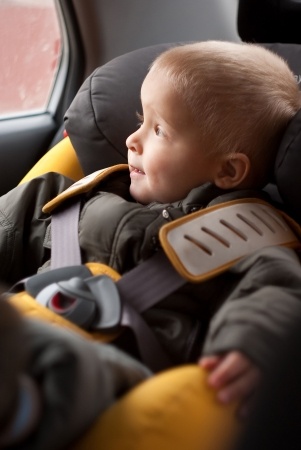 This is National Child Passenger Safety Week, when parents can get answers to common questions about driving safely with their children.
This is National Child Passenger Safety Week, when parents can get answers to common questions about driving safely with their children.
National Child Passenger Safety Week began last weekend and is observed by the National Highway Traffic Safety Administration (NHTSA) and local communities. It ends this weekend with National Seat Check Saturday.
Motor vehicle accidents are one of the leading causes of death for children in the United States. Child safety seats reduce the risk for injury if they are used properly, by more than 70 percent when it comes to infants and more than 50 percent for children age 1 to 4. But parents have long struggled with how to use them. In one study, more than 70 percent of 3,500 observed car and booster seats were misused in a way that could harm children, according to the Centers for Disease Control and Prevention (CDC).
Parents should also closely examine their child safety seat models this year. Several months ago, Graco recalled more than 6 million child safety seats, the largest car seat recall in U.S. history. Parents reported they were unable to unbuckle defective harnesses and had to cut their children out of the straps. The cause was food was getting dried up in the harnesses and causing them to stick.
Child passenger safety laws have changed over the past decade and every state now has a law for infants and children-fitting specific criteria. All but two (Florida and South Dakota) require booster seats for older children. The Massachusetts Child Passenger Safety Law requires children to ride in federally-approved child passenger safety seats that are properly secured until they are eight years old or over 57 inches tall.
Despite laws for older children, Safe Kids, a national non-profit organization, has released a new report, showing 7 in 10 parents did not know a child should be at least 57 inches or 4’9″ tall before they ride in a car without a booster seat. The organization surveyed 1,000 adults.
A few resources on child safety seats:
Check Your Car Seat Label. Become informed about the specifics of car seats. Make sure yours fits your child’s weight, size and age. For infants through age two, look for a rear-facing child safety seat. For children between ages 2 -4 or up to 40 pounds, choose a forward facing child safety seat. From age 4 to 8 or 57 inches, children should ride in belt positioning booster seats. Read more.
Car Safety Seat Checklist for Parents. Safe Kids has developed this checklist for parents.
Register Your Car Seat. Here is a resource from the NHTSA on registering your car seats with the manufacturer. This will allow the manufacturer to contact you if there is a defect.
Used Car Seat Safety Checklist. Here is a resource from the NHTSA on using used child safety seats.
Community Events. Some organizations offer free car seat safety inspections this weekend as part of National Seat Check Saturday and allow parents to make appointments with trained professionals throughout the year. Here is a directory of locations or you can contact your local police department to ask about resources in your community.
Read More
Boston Mayor Proposes New Truck Safety Ordinance
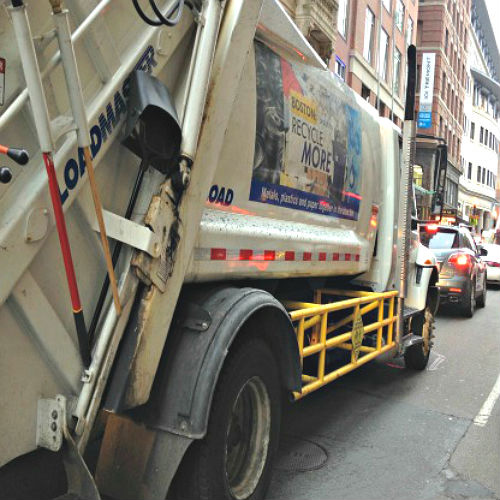
Mayor Marty Walsh is proposing a new safety ordinance for city-contracted trucks in Boston, a measure being widely watched after several cyclists have died in truck crashes. It is believed to be the first such ordinance in the nation.
Walsh, who took office in January, submitted an Ordinance to Protect Vulnerable Road Users to the Boston City Council earlier this week. The City Council was expected to take it up today in session.
If passed, the ordinance will require side guards, convex mirrors, cross-over mirrors, and blind-spot awareness decals on all vehicles over 10,000 pounds which are contracted with the city. The goal is to prevent truck accidents by giving drivers a better view around them. When trucks do not comply, fines start at $100 for the first offense and contracts can ultimately be terminated.
The Boston Cyclists Union called for these measures after a cyclist was killed in a Charlestown truck accident in April. It has released a fact sheet, “Safeguards Saves Lives.” According to the fact sheet, 4 percent of vehicles in the U.S. are trucks though they cause 11 percent of all bicyclist fatalities and 7 percent of all pedestrian fatalities.
Since 2010, 11 cyclists in Boston have died as a result of motor vehicle crashes, according to figures cited by Boston Magazine. Seven cases involved trucks. Here is another concerning figure: From 2009 to 2012, there were 1,700 confirmed cyclist incidents documented by Boston EMS emergency medical technicians and paramedics.
The City of Boston has been working on truck safety. Last year, the city began a pilot program, the largest in the nation. The Mayor’s Office of New Urban Mechanics and the city’s Public Works Department tested three different types of guards on 16 active vehicles driving the streets.
In April, the National Traffic Safety Board made similar recommendations to prevent tractor-trailer accidents.
About Breakstone, White & Gluck
The Boston personal injury lawyers at Breakstone, White & Gluck have over 100 years combined experience representing injured cyclists and pedestrians. We support efforts to make the roads of Boston safer and donate bike helmets for children each year, in Boston as well as Cambridge and Somerville and other communities. For a free legal consultation, visit 800-379-1244 or 617-723-7676 or use our contact form.
Motorcycle Safety Awareness Month: Safety Reminders and Our Experience Representing Injured Riders
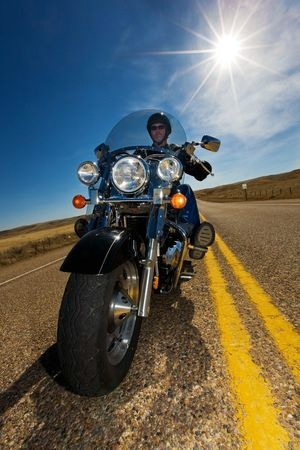 Before June begins, we have a final thought for May, which was Motorcycle Safety Awareness Month.
Before June begins, we have a final thought for May, which was Motorcycle Safety Awareness Month.
Motorcycle use continues to grow in the U.S. but so do motorcycle accidents. For 15 years now, we have seen an annual increase in motorcyclist fatalities, according to the National Highway Traffic Safety Administration (NHTSA). The one exception was 2009. When motorcyclists survive, they are also suffering more non-fatal injuries. In 2012, 93,000 motorcycling injuries were reported, 12,000 more injuries than in 2011.
A few safety reminders for drivers:
- Remember motorcyclists have all the same rights, privileges and responsibilities as other motorists.
- Allow motorcyclists a full lane width.
- Give motorcyclists extra following distance when you are behind them.
- Before you switch lanes, always check your vehicle’s mirrors and your blind spot for motorcyclists.
- Make sure you signal your intention to change lanes or merge with traffic.
- Do not rely on a motorcyclist’s flashing turn signal. The rider may have forgotten to turn it off or it may not be self-cancelling.
A few safety reminders for motorcyclists:
- Remember to wear your helmet and do not let any passengers ride without one. In 2012, overall motorcycle helmet use fell to 60 percent. Passenger helmet use dropped to 46 percent.
- Wear reflective tape whenever possible.
- Do not consume alcohol when you are operating.
- Obey traffic laws. You must have a special license to operate a motorcycle in Massachusetts and that is important. Some 24 percent of all riders who are involved in fatal motorcycle crashes are operating with invalid licenses.
Our Experience Representing Injured Riders
The Boston personal injury lawyers at Breakstone, White & Gluck have over 100 years combined experience handling automobile and motorcycle accident cases.
Read about one case attorney Ronald Gluck handled for an injured motorcyclist. Gluck’s client was seriously injured when a negligent driver cut into his lane and struck his motorcycle. He suffered numerous injuries, including facial fractures, concussions, blindness in one eye and a shoulder injury and had to undergo surgeries. Gluck negotiated a $3.75 million settlement.
Read about the case on our website.
Read the client’s review on Avvo or below.
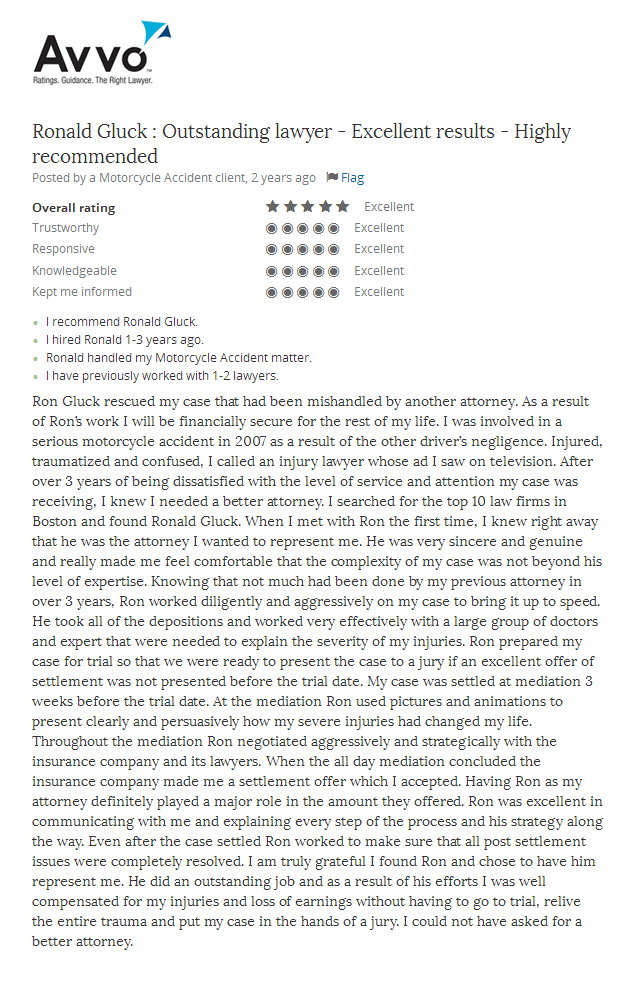
Contact Breakstone, White & Gluck in Boston
If you have been injured in a motorcycle accident, it is important to access immediate medical treatment. Then learn your rights for seeking compensation. For a free legal consultation, contact us at 800-379-1244 or 617-723-7676 or use our contact form.
22 Years and Counting!
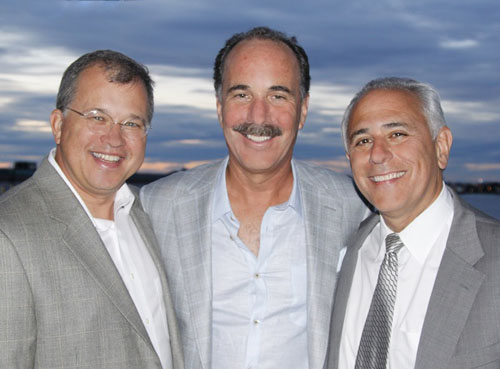
Founded in May 1992, Breakstone, White & Gluck celebrates its 22nd anniversary this week. Our law firm has been guided by a commitment to provide consistently excellent representation to individuals and families who have been seriously harmed by the negligence of others. We feel honored to help our clients not only obtain full and fair financial compensation, but also the best possible medical and personal end-results. We are grateful to the innumerable referring attorneys who have entrusted their clients’ cases to us. We are thankful to our own families for their love and support. We look forward to continuing to serve our community and our clients in the future. Thank you.
Amazing Kids Learn Important Cycling Skills at iCan Shine Camp in Arlington
This blog is about a special bicycle camp that is being held in Arlington this week. Breakstone, White & Gluck was happy to donate bike helmets to support the iCan Shine Bike Camp, which fills a very important need and teaches children with disabilities how to ride bicycles. Please read about the camp, its organizer Nina Fischer and all the energetic and skilled instructors and volunteers.
This April school vacation was not a traditional break for two dozen children in Arlington. These children with disabilities spent their time off hard at work, learning how to ride bicycles at the iCan Shine Bike Camp at the Ottoson Middle School.
Children with disabilities do not have as many options for learning to ride and it is especially important in communities near Boston where cycling is so popular, said Nina Fischer, the camp’s organizer. Fischer tried to get her daughter who has cerebral palsy into bike camps for three years (including one as far away as New Jersey) before being approached to organize an iCan Shine Bike Camp locally. iCan Shine is a national non-profit organization which teaches children with disabilities how to ride bicycles. Each year, it hosts nearly 100 camps in 32 states.
Fischer said the children come ready to learn from professional instructors from the iCan Shine national organization. Add in supportive parents and volunteers who agree to guide the children on bikes five days in a row, and the combination all proves very successful.
“This is a skill they have for life,” Fischer said. “Most of these kids don’t have to come back.”
Breakstone, White & Gluck donated the bike helmets for the camp and attorney Marc Breakstone attended and got to meet the young cyclists. He said, “We are so pleased to give helmets to these courageous kids to help make sure that they ride safely.”
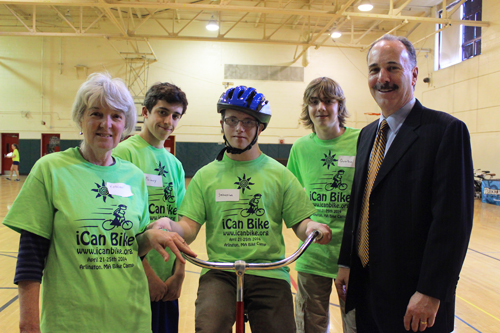
Fischer organized the first Arlington camp last year and her daughter participated. But this year, her daughter decided she had learned enough not to come back.
“That’s what is great,” Fischer said. “Once you have it, you pretty much have it down.”
But she added, “I’m totally hooked. I can’t imagine not doing it. Someone has to do it.”
According to the national organization’s website, about 80 percent of the children can successfully ride bikes independently by the end of the five-day camp. Nationwide, about 35 percent of the participants have Down Syndrome, 35 percent are on the Autism Spectrum and the rest have other diagnosis, Fischer said.
We attended on Tandem Tuesday, when the national instructors gave each child a turn riding on the front of the tandem bike. An instructor sat on the back seat to assess the child’s steering ability and strength.
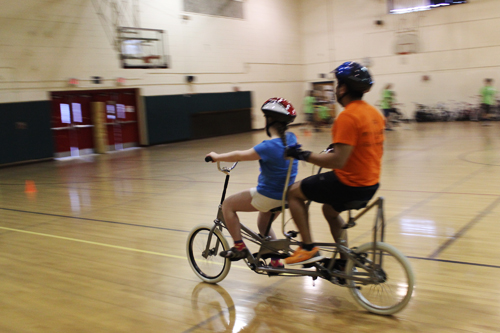
We also got to see the children make their way around the school gym with the specialized adaptive rear wheel equipment. These wheels are developed from research by Dr. Richard Klein at the University of Illinois. They are now made by his company Rainbow Trainers, Inc.
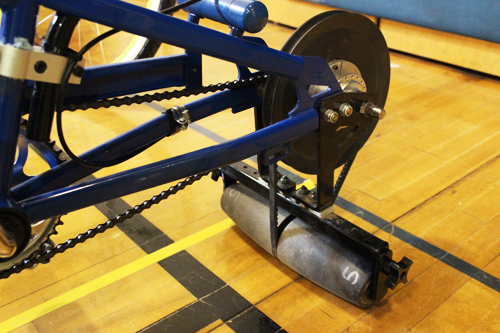
To help the children learn cycling, over the course of a few hours, the iCan Shine instructors change the strength of the bicycle rear tires up to 8 or 10 times. The children are not supposed to know about the change and are encouraged to get a cup of water or take a short break while the change happens.
While using these special rear wheels, children are riding bikes provided by the national iCan Shine organization. These bikes have no brakes. The children rely solely on their own steering and the volunteers to guide them.
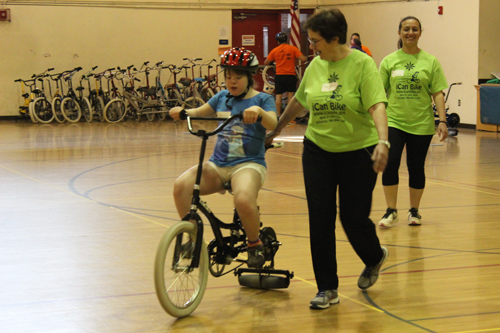
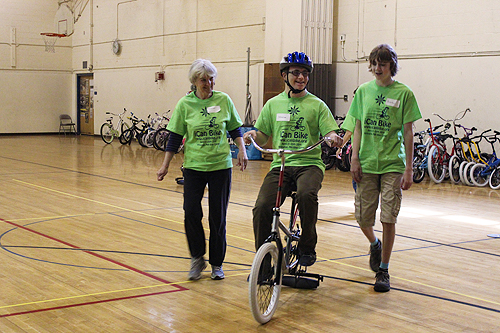
By mid-week, the children progress to two-wheel bikes with brakes. Later in the week, the instructors will start to work with Belmont Wheelworks and the children’s parents on ordering bikes which will best suit each child. They then take the bikes to the gym to practice with the iCan Shine instructors.
“Sometimes that transition is difficult, rocky,” said Andrea Patrick, floor supervisor for the national iCan Shine program. “That’s why we try to do it at camp, where they have learned the skills and it is a safe environment.”
About Breakstone, White & Gluck
Breakstone, White & Gluck, a Boston personal injury law firm, encourages all cyclists to wear bike helmets to reduce the risk of serious head injuries while riding.
According to the Centers for Disease Control and Prevention, bicyclists face a higher risk of crash-related injuries than drivers and occupants of motor vehicles. Children ages 5-14 and young adults ages 15-24 have the highest rates of non-fatal bicycle related injuries and account for 60 percent of all bike-related injuries seen in U.S. hospital emergency rooms.
In 2013, we were proud to donate over 1,000 bike helmets to children in the Boston area. We are donating more helmets this year. To learn more about our bicycle safety outreach, visit www.bwglaw.com/project-kidsafe/. We also invite you to follow our Facebook page.
Healthy Lifestyle Wristbands Causing Skin Rash
 As it turns out, a popular wristband for tracking sleep and exercise was actually contributing to poor health.
As it turns out, a popular wristband for tracking sleep and exercise was actually contributing to poor health.
The Fitbit Force wristband has been recalled and pulled off the market after 9,900 reports it caused skin irritation. Another 250 consumers reported blistering. The product had only been on the market since October. The company has recalled about one million wristbands in the U.S. and 28,000 in Canada. The reactions can be caused by the stainless steel casing, materials used in the strap and adhesives used to assemble the product, the Consumer Product Safety Commission (CPSC) announced in its recall notice last week.
This recall involves Fitbit ForceTM wireless activity-tracking wristbands with model numbers FB402BK, FB402BKS, FB402SL and FB402SLS. Consumers should contact San Francisco-based Fitbit for a full refund. They can call (888) 656-6381 or visit www.fitbit.com and click on Recall/Safety info on the bottom right side of the home page.
The wristband serves as a pedometer, sleep monitor and watch. It is about ¾ inch wide and is made of plastic with a stainless steel casing and clasp and a small LED display screen.
The recalled wristbands had a wide distribution. They were sold at several major retailers, including AT&T, Apple Stores, Best Buy, Brookstone, Dick’s Sporting Goods, Radio Shack, REI, Sports Authority, Target and other stores. It was sold online at Amazon.com and Fitbit.com. Each was sold for about $130.
In a statement to the media, Fitbit said that “a thorough analysis by independent labs and medical experts revealed that the reactions reported by a small percentage of Force users were likely the result of allergic contact dermatitis.” The exact number appears to be in dispute as consumer watchdogs questioned the figures following the CPSC recall announcement. The company had previously issued a voluntary recall on its own on Feb. 21, offering a refund to consumers who wanted one.
Related:
Fitbit Recalls Force Activity-Tracking Wristband Due to Risk of Skin Irritation, Consumer Product Safety Commission
Reports of Rashes Spur Fitbit Recall, ABC News.
About Breakstone, White & Gluck
The Massachusetts product liability lawyers at Breakstone, White & Gluck have over 100 years combined experience handling injury cases involving defective products. If you have been injured, it is important to learn your rights. For a free legal consultation, contact us at 800-379-11379 or 617-723-7676 or use our contact form.
How Dangerous Is That Boston Intersection?
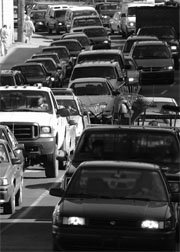 Boston drivers may have a reputation for being the worst around, but the city has managed to stay off a list of most dangerous intersections in New England. On the list, compiled by GoLocal Worcester, the closest Boston came to mentions were intersections in Somerville, Chelsea and Cambridge.
Boston drivers may have a reputation for being the worst around, but the city has managed to stay off a list of most dangerous intersections in New England. On the list, compiled by GoLocal Worcester, the closest Boston came to mentions were intersections in Somerville, Chelsea and Cambridge.
This Somerville intersection of Mystic Avenue and Fellsway was third on GoLocal Worcester’s, “60 Most Dangerous Intersections in New England” and first on its, “10 Most Dangerous Intersections in Massachusetts.”
60 Most Dangerous Intersections in New England
New Haven, Connecticut is home to the worst intersection in New England, with 561 car crashes reported over three years. A stretch of Interstate 95 in Pawtucket, Rhode Island came in second, while Somerville’s Mystic Avenue and Fellsway intersection ranked third.
10 Most Dangerous Intersections in Massachusetts
GoLocal Worcester ranked dangerous intersections based on total number of crashes over three years, deaths, injuries and property damage. It collected data from each state’s Department of Transportation. It considered traditional intersections as well as on- and off-ramps on highways.
1. Somerville: Mystic Avenue and Fellsway. This intersection saw 91 total crashes over three years, including three fatal crashes, 24 crashes resulting in injuries, and 64 car accidents which resulted in property damage only.
2. Chelsea: Revere Beach Parkway and Washington Avenue. This roadway saw 39 total crashes in three years, including two fatal car accidents, 11 with injuries, and 26 crashes which resulted in property damage only.
3. Stoughton: Canton and School streets. The numbers were very similar to Chelsea: 39 car accidents in three years, including two fatal auto accidents, 10 with injuries and 27 with property damage only.
4. Waltham: Main and Lyman streets. Some 73 crashes in three years, including one which resulted in a death, 18 resulting in injuries and 54 crashes with property damage only.
5. Holyoke: Main and Cabot streets. This spot saw 57 car accidents over three years, including one fatal car crash, 18 with injuries and 38 which resulted in property damage only.
6. Worcester: Main and Mill streets. This area saw 53 total motor vehicle accidents, including 1 traffic death, 18 crashes resulting in injuries and 34 resulting in property damage only.
7. Cambridge: Massachusetts Avenue and Vassar Street. This area saw 41 car crashes, including one fatal accident, 19 with injuries and 21 with property damage only.
8. Lowell: Veterans of Foreign Wars Highway and Varnum Avenue. This area saw the second highest number of traffic accidents, with 165 over three years. There were no fatal car crashes, 37 with injuries and 128 which resulted in property damage only.
9. Holyoke: Holyoke Street and Holyoke Mall at Ingleside. This intersection saw 198 crashes over three years, more than any other spot on GoLocal Worcester’s list. There were no fatal car accidents, but there were 29 accidents resulting in injuries and 169 crashes resulting in property damage only.
10. Lowell: Bridge Street and Veterans of Foreign Wars Highway. There were 112 car accidents here over three years, including no fatal crashes and 34 which resulted in injuries. Some 78 other motor vehicle accidents resulted in property damage only.
Related:
10 Most Dangerous Intersections in Massachusetts.
60 Most Dangerous Intersections in New England 2014.
Read More
Study: 40 Percent of Americans Would Encourage Children Not to Play Football
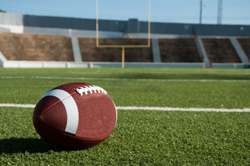 Last summer, the National Football League (NFL) announced it had reached a $765 million settlement with retired players who suffered from concussions and head injuries. But a federal judge has rejected the settlement and the debate about how to address the risk continues.
Last summer, the National Football League (NFL) announced it had reached a $765 million settlement with retired players who suffered from concussions and head injuries. But a federal judge has rejected the settlement and the debate about how to address the risk continues.
Even President Barack Obama has spoken: “I would not let my son play pro football,” he told The New Yorker magazine. But like many of us, he is a fan; he made the statement while watching the Miami Dolphins play the Carolina Panthers.
Recent surveys show many agree with the president, but many do not. In January, a NBC News/Wall Street Journal poll reported 40 percent of Americans would encourage their children to play another sport. Nearly 60 percent answered they would not discourage their children from playing organized football. Other findings include:
- Some 41 percent thought the NFL has taken meaningful action to reduce and prevent concussions; 20 percent disagreed.
- Roughly half of those surveyed with an annual salary of $75,000 or more said they would encourage their child to play another sport. On the other hand, only about 25 percent of those who earned $30,000 or less per would try to steer their child to another sport.
- One third of those who did not attend college said they would encourage their children not to play football, compared to 42 percent of college graduates and 57 percent of people with post-graduate degrees.
The NBC News/Wall Street Journal poll included 800 adults and had a margin of error plus or minus 3.46 percentage points.
Another Poll
In October, a HBO Real Sports/Marist poll reported a deeper divide. Out of more than 1,200 adults, one third said they would be less likely to allow their own son to play football if given the choice. But in the end, 85 percent said they would let their son play. Another 13 percent said they would not and two percent were unsure. (The study did not report on how respondents would feel about letting their daughters play.)
NFL Concussion Lawsuit
The NFL released figures in January showing the number of player concussions dropped 13 percent from 2012 to 2013. It has taken several steps to prevent concussions, including adding neurological consultants to the sidelines and replacing equipment.
But another notable part of the debate came from a recent NFL Nation survey of 320 players, just prior to the Super Bowl. The survey reported 85 percent would play in a Super Bowl with a concussion.
More than 4,500 retired players have filed concussion-related lawsuits against the NFL. The settlement must cover over 20,000 retired players for 65 years. The players accuse the league of long concealing the long-term risk of concussions from players, coaches and trainers. If an athlete suffers multiple concussions, it can lead to chronic traumatic encephalopathy (CTE), a progressive degenerate disease of the brain which is associated with memory loss, depression, paranoia, confusion and dementia.
Related:
Going the Distance, The New Yorker.
Poll Finds 40 Percent Would Sway Children Away from Football, Wall Street Journal.
Read More
Heaving Snow Posing Risk for Homeowners and Roofs
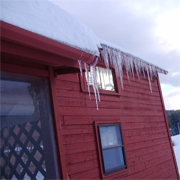 A young woman’s death after heavy snow caused a roof collapse in Weymouth has officials warning the public to watch out for their homes.
A young woman’s death after heavy snow caused a roof collapse in Weymouth has officials warning the public to watch out for their homes.
On Thursday, a 29-year-old woman was killed when a carport collapsed on her. The woman was talking on the phone while sitting on the porch steps of a Harlem Road home. The Massachusetts Emergency Management Agency (MEMA) has issued a warning for the public to clear off their home roofs and storm drains in their neighborhoods to minimize flooding problems.
While we expect snow in Massachusetts, it has challenged drivers and caused numerous school day cancellations this season. Piles of snow have hampered visibility. Drivers are navigating a maze of snow-packed and slushy roads along with dangerous potholes and, which are starting to appear in the melting.
In addition to the Weymouth woman’s death, a barn collapse in Framingham killed three cows and injured four others this week. At the Burlington Mall, a water main break trapped a vehicle in a large sinkhole. The mall was closed but expected to re-open today.
It may seem like a record-setting season, but not this year. Yes, we are already 25 inches above the average season’s snowfall. But earlier this week (before the snowfall) the Boston Herald reported that while Boston had seen 53.5 inches, 1995-1996 was the record snow year, with 107.6 inches. The National Weather Service has predicted this season will not even make the top 10 list for heaviest snowfalls.
When snow piles up, some roofs are vulnerable to collapse, especially when there are numerous snow storms combined with rain and overnight melting. Flat commercial roofs are at the greatest risk. This year, while the snow may not appear that deep, some of the storms have dumped heavy wet snow, and that has been followed by soaking rains. The loads are immense.
How to remove snow from a roof is a challenge. Homeowners can attempt to clear it themselves with a snow rake, which can be purchased at most hardware stores. But you should never use a snow rake from a roof. You should clear the snow from the ground to avoid the risk of slipping and falling and head injuries.
Unless you are experienced, avoid ladders, which can be extremely slippery. The other thing to know is that metal snow rakes can conduct electricity if they come into contact with a power line.
Often by this time of year, a roof may require a professional treatment because of repeated snow storms and winter freezing. If that is the case, call someone who is experienced and insured for this type of work. They should be insured in case they damage your home, and they should also carry worker’s compensation insurance for their employees. You have the right to ask for proof of insurance, and you should.
Finally, do take some time to shovel your walks and your stairs. It the safe and the neighborly thing to do.
Read More
What to Know About the the Graco Child Safety Seat Recall
 Parents across the country are checking their backseats after Graco issued one of the largest child safety seat recalls in history this week. It may not be the last recall either; the Georgia-based company is facing pressure from the National Highway Traffic Safety Administration (NHTSA) to recall 1.8 million additional seats.
Parents across the country are checking their backseats after Graco issued one of the largest child safety seat recalls in history this week. It may not be the last recall either; the Georgia-based company is facing pressure from the National Highway Traffic Safety Administration (NHTSA) to recall 1.8 million additional seats.
Graco recalled 3.7 million car seats manufactured between 2009 and 2013, the fourth largest recall ever for safety seats and the largest in five years, according to media reports. The NHTSA announced Tuesday that Graco was voluntarily recalling 11 models, though the agency had sought recalls of 18 models. The agency has stated it could take legal action to force the recall of the other models, which are rear-facing models for infants.
The car seats have defective buckles, which can be difficult to unlatch or become stuck. Graco said it was not aware of any injuries resulting from the car seat, but the New York Times reports the NHTSA began investigating Graco in 2012, after parents complained to regulators about having to cut children out of the seats from straps. One parent said it took her 45 minutes to loosen the straps enough to pull her daughter out.
But there is at least one case of serious injury. In a Jan. 14 letter to Graco, the NHTSA noted the company was a defendant in a wrongful death lawsuit in Los Angeles Superior Court in which a two-year-old child was killed in a fire following a car crash. The child was traveling in a Graco Nautilus car seat. The company has said the wrongful death case was resolved by a confidential settlement agreement.
Read the full list of recalled car seats. Parents who have defective car seats can contact Graco for a free replacement buckle. Graco says the seats are safe to use until parents obtain a replacement, but the NHTSA is urging parents to find other seats until they receive the new buckles.
Parents want to be able to trust the car seats, strollers and cribs they use to care for their children. Because these are important purchases, many parents and family members spend time researching and reading consumer reviews on Internet shopping sites such as Amazon.com before purchasing.
These reviews are helpful, as is feedback from other parents. But there are a few other steps parents can take:
Mail in the product registration. You want to make sure the company knows you have its product and need to be notified of any defect or recall and be included in the remedy process.
Do your research. Search the NHTSA database for car seat recalls.
Car seat inspection. Visit this NHTSA website page to search for sites where you can get your car seat inspected. Watch as the certified professional fits your child’s car seat and what to watch as you go about your daily driving routine.
Check your product. Remember a few basics about all children products, from toys to car seats. First, make sure they do not have small parts which can easily break and become a choking hazard. Make sure your child can move freely in seats with straps. Make sure the product can fully support your child by reading the age and weight requirements.
Read More

